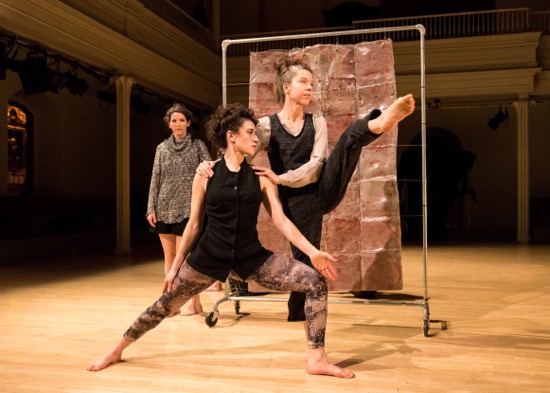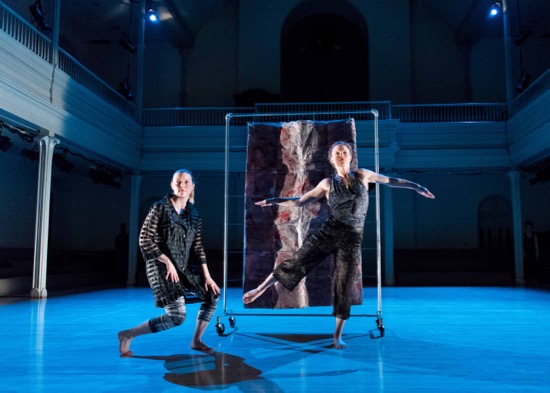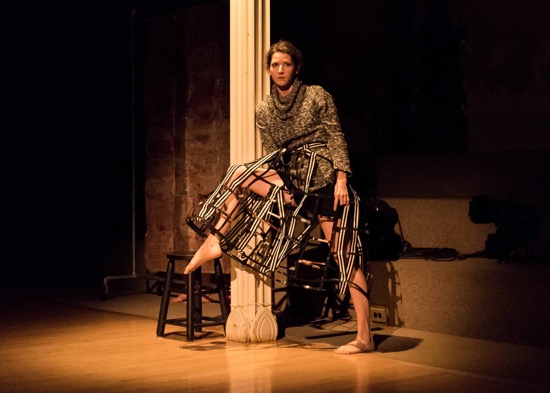Danspace Project presents Vicky Shick and Dancers, January 5 through 7.

(L to R): Heather Olson, Lily Gold, and Donna Costello in Vicky Shick’s Another Spell (dress rehearsal). Photo: Ian Douglas, courtesy of Danspace
I didn’t see Vicky Shick’s Another Spell when it premiered last April, but I know that the evening I attended the revival of this Danspace Project commission, it began the same way it did back then. Shick genially confronts those of us sitting in St. Marks Church waiting for the performance to begin. What? The choreographer has the job of telling us to turn off our cell phones and of indicating the exits and the location of the rest rooms? Then she says, “The characters in this piece are fictitious. Any resemblance to persons living or dead is purely coincidental.” Did she then wink at us? No. Hmm. She may be obliquely warning us not to look for stories, even though we see behavior that might tempt us to do that.
Another Spell is inhabited by a community of women: Jodi Bender, Donna Costello, Lily Gold, Laurel Jenkins (replacing Omagbitse Omagbemi), Marilyn Maywald-Yahel, Heather Olson, and Shick. All these fascinating dancers, the program tells us, contributed to the choreography. The set and costumes are by Shick’s longtime collaborator, sculptor Barbara Kilpatrick. At the back of the space sits a large metal rack, cousin to the small one that holds spectators’ coats. Draped over its horizontal bar is a slightly gleaming mass of black fabric; look at it closely the one time it is wheeled nearer, and you can see it as one or more very long coats; two skinny, far-apart sleeves stick out from it (did the witch who cast the spell leave it behind?) A second rack on wheels holds a quilt of sorts; it’s made of squares of a stiff, red-brown material that makes me think of dried animal hide, and the reverse side glimmers with the addition of clear plastic. This object is used to conceal or reveal performers. At one point, Gold stands on its bottom rail and holds onto its sides, while the others (all but Shick) run with it and spin it around.

Jodi Bender (L) and Marilyn Maywald-Yahel in Vicky Shick’s Another Spell. Photo: Ian Douglas, courtesy of Danspace Project
Elise Kermani—who, like Kilpatrick, has collaborated with Shick many times—has, with Todd Lent, composed and recorded a rich and mysterious score. You may hear, for example, sounds that suggest wailing, bells buried within a continuum, a low tolling, a ringing, a thudding. Rhythms and melodies coalesce and dissolve, voices arise. So do crashing sounds. Once, the women onstage sing wordlessly (“aaah”). Often silence falls.
The dancing is luscious, fluid and weighted but also precise. The performers’ eyes may follow a gesture or seem to cause one. Imagine supple women doing housework in a fantasy kingdom (this goes up on this shelf, what’s that on the floor, did I hear someone knock, something’s on my foot). They also look at us a lot—striking a symmetrical group pose; rushing toward us but collapsing on the floor before they get too near. For one tableau, they first bend forward, apparently fixing their hair, but when they straighten up and confront us, stockings cover their faces, flattening their noses and compressing their cheeks—a disguise that lasts only a few seconds.
Nothing ruffles the composure of these women; they perform every task with care, and smoothly transform it into something else. If Costello lifts a straight leg and slaps it down on the floor in front of her, she conveys neither assertiveness nor weariness. We don’t wonder about narrative cause and effect. When Maywald-Yahel follows a big stretching move with beating her hands on one thigh, then raises a loosely curled fist and moves it slowly toward her nose before turning the gesture briefly into something like a salute, you’d best not ponder possible meanings. These women are swimming through montages, in which what they’re doing now may cousin up to something they experienced yesterday or dream of for tomorrow.

Heather Olson in Vicky Shick’s Another Spell. Photo: Ian Douglas, courtesy of Danspace Project
Some of the actions transform the mundane into enigmas. When Olson is revealed leaning against a pillar, wearing the framework of a hoop skirt, you don’t wonder why she is so garbed (in our first glimpse of her, when the wheeled structure is moved away for just a second, she’s in the process of fastening the waistband). She drinks some water from a bottle. A quick kiss ends a duet between Gold and Costello, just the way two friends might say goodbye after a rehearsal. Maywald-Yahel enters with a folded piece of paper and gives what’s obviously a letter or a notice to Jenkins, Olson, and Costello; they cluster together and read it. Then Olson takes it away. What any of them thinks about its contents we’ll never know, just as we can’t guess what one woman whispers to another or why they all run loosely and happily around.
And trying to fathom such events would be as pointless as wondering why Gold spreads her fingers speculatively, or why Maywald-Yahel, staring at us, slowly rubs one clubbed foot down the leg she’s standing on, or why Jenkins, at another point, grabs Maywald-Yahel by the neck of her costume and runs her toward us. Kathy Kaufman’s subtle and skillful lighting may cool the space down or turn it golden, but not in order to indicate a day’s passing.
Shick—who dances (wonderfully) less frequently than the others—further warns us against digging for linear narratives by having many of the actions that seem spontaneous repeated later in the dance. For instance, two pairs in unison execute the grabbed-by-the collar run.
The women may come and go, but they don’t disappear. Instead they sit on the church’s side risers and wait for the next sequence that requires their presence. Bender, Costello. . . they all have moments alone. Two of them may dance in unison. Or in counterpoint, as Shick and Jenkins once do. Six may work in two trios. And, in various ways, they line up, bellies to backs, and progress like a train. Or cluster.
Another Spell, which I saw on its opening night, may have been subtly different at subsequent performances. I’ve learned that Shick felt it was a little too long and was contemplating small cuts. That’s probably a good idea. But she has created an absorbing world, in which women embed everyday occurrences in their dancing and make that dancing seem as personal, as daring, and as full of surprises as the lives they are living.

I hope Vicky Shick contines to present this engaging, beautiful work to more audiences. It’s a must-see and a powerful and tender statement about living and loving.